
The Vitaceae are a family of flowering plants, with 14 genera and around 910 known species, including common plants such as grapevines and Virginia creeper. The family name is derived from the genus Vitis.

Baron Sir Ferdinand Jacob Heinrich von Mueller, was a German-Australian physician, geographer, and most notably, a botanist. He was appointed government botanist for the then colony of Victoria (Australia) by Governor Charles La Trobe in 1853, and later director of the Royal Botanic Gardens, Melbourne. He also founded the National Herbarium of Victoria. He named many Australian plants.

Ampelopsis, commonly known as peppervine or porcelainberry, is a genus of climbing shrubs, in the grape family Vitaceae. The name is derived from the Ancient Greek: ἅμπελος (ampelos), which means "vine". The genus was named in 1803. It is disjunctly distributed in eastern Asia and eastern North America extending to Mexico. Ampelopsis is primarily found in mountainous regions in temperate zones with some species in montane forests at mid-altitudes in subtropical to tropical regions. Ampelopsis glandulosa is a popular garden plant and an invasive weed.
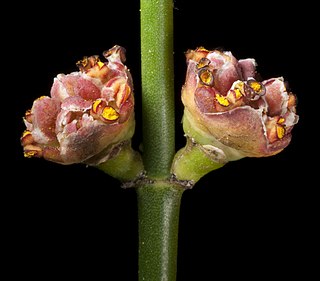
Calycopeplus is a plant genus of the family Euphorbiaceae first described by Jules Émile Planchon as a genus in 1861. The entire genus is endemic to Australia. Its closest relative is Neoguillauminia from New Caledonia.

Bosistoa is a genus of four species of tree in the family Rutaceae endemic to eastern Australia. They have simple or compound leaves arranged in opposite pairs and bisexual flowers arranged in panicles, each flower with five sepals, five white petals and ten stamens.
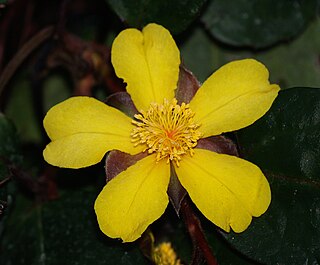
Hibbertia dentata, commonly known as toothed guinea flower, trailing guinea flower or twining guinea flower, is an ornamental plant in the family Dilleniaceae native to the east coast of Australia. Found in woodland, it is a trailing or twining vine with leaves with several small 'teeth' on the margins and bright yellow flowers in early spring. It adapts readily to cultivation and can be grown as a pot plant. The species was first described in 1817.

Vitis (grapevines) is a genus of 79 accepted species of vining plants in the flowering plant family Vitaceae. The genus is made up of species predominantly from the Northern hemisphere. It is economically important as the source of grapes, both for direct consumption of the fruit and for fermentation to produce wine. The study and cultivation of grapevines is called viticulture.
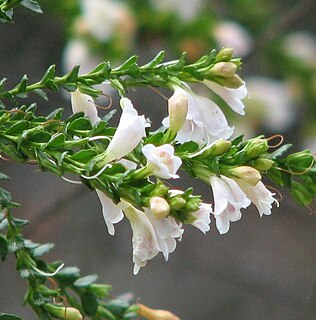
Eremophila brevifolia, also known as spotted eremophila, is a flowering plant in the figwort family, Scrophulariaceae and is endemic to the south-west of Western Australia. It is an erect, open, spindly shrub with sticky, short, serrated leaves and white to pink flowers and is only known from a few scattered populations.

The Great French Wine Blight was a severe blight of the mid-19th century that destroyed many of the vineyards in France and laid waste the wine industry. It was caused by an aphid that originated in North America and was carried across the Atlantic in the late 1850s. While France is considered to have been worst affected, the blight also did a great deal of damage to vineyards in other European countries.
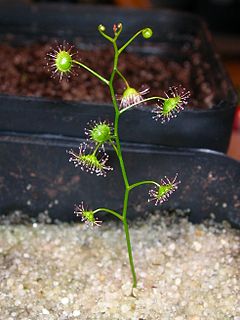
Drosera sect. Ergaleium is a section of 26 species that are erect or scrambling tuberous plants in the genus Drosera. This section represents a natural group and are taxonomically monophyletic.
Vitis shuttleworthii is a North American liana in the grape family commonly known as the caloosa grape. It is native to south and central Florida, with isolated populations in southern Alabama.

Rhoicissus rhomboidea is a climbing plant in the family Vitaceae, commonly known as the glossy forest grape. It is found in the eastern forests of southern Africa. The species was first described in 1859, treated under Cissus.

Clematicissus opaca, called small-leaf grape, pepper vine, small-leaved water vine, yaloone and wappo wappo, is a small vine endemic to Australia. Pepper vine is naturally found in rocky locales in monsoon forest, littoral rainforest and open forest, and is occasionally grown as a garden plant. The plant is primarily restricted to coastal and sub-coastal regions in Queensland and New South Wales, although it does occur inland, west of the Great Dividing Range, in central New South Wales,

Harpullia hillii, commonly known as blunt-leaved tulip or oblong-leaved tulip, is a tree in the family Sapindaceae, endemic to eastern Australia. Although the species may grow to 20 metres high, most trees are less than 10 metres high. Each leaf comprises 4 to 12 leaflets, that are oblong or elliptic oblong and between 5 and 15 cm long and 2 to 6 cm wide. White flowers with petals 10–12 mm long appear in panicles that are 10–25 cm long. These are followed by orange fruit that are 25–30 mm in diameter and 12–14 mm long. The fruit, which is positioned above the persistent sepals, becomes woody with age. The glossy black seeds protrude from red arils.
Hollandaea sayeriana, sometimes named Sayer's silky oak, is a small species of Australian rainforest trees in the plant family Proteaceae.

Hemiphora is a genus of five species of flowering plants in the mint family, Lamiaceae and is endemic to Western Australia. Plants in this genus are woolly shrubs with warty, hairy leaves and with five petals joined to form a tube-shaped flower with four stamens. These species are similar to those in the genus Chloanthes in that the base of the leaves extends down the stem. They differ from Chloanthes, in that the leaves only extend a short distance down the stem.
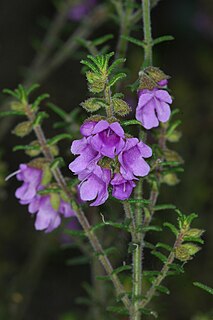
Prostanthera decussata, commonly known as dense mintbush, species of flowering plant that is endemic south-eastern Australia. It is a dense, compact, strongly aromatic shrub with egg-shaped leaves and mauve to violet flowers with yellow streaks, arranged in leaf axils near the ends of branchlets.

Cissus cornifolia is a species of flowering plant in the Vitaceae family. It is an erect or semi-scandent woody shrub up to 3 meters in height belonging to the grape family of Vitaceae, and found from sub-Saharan Africa and Tropical Africa south to Botswana, Mozambique and South Africa. It is one of more than 300 species forming the genus Cissus.
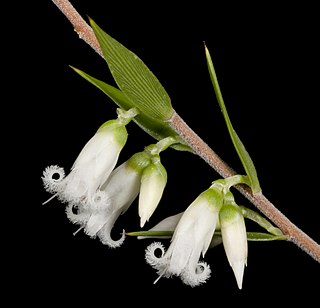
Styphelia conostephioides is a plant in the family Ericaceae native to Western Australia. It was first described in 1839 as Leucopogon conostephioides by Augustin Pyramus de Candolle. In 1867 Ferdinand von Mueller transferred it to the genus, Styphelia, but the accepted name continued to be Leucopogon conostephioides. However in 2020, with a publication concerning the phylogeny of Styphelia by Crayn and others, the name Styphelia conostephioides was accepted by the Herbarium of Western Australia.
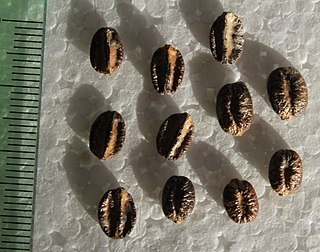
Ampelocissus martini is a species of climber or shrub in the Vitaceae family. Some sources use the spelling Ampelocissus martinii. It is native to an area of Mainland Southeast Asia. The fruit are eaten by people and by several species of Pangasiidae shark catfish of the Mekong river.



















